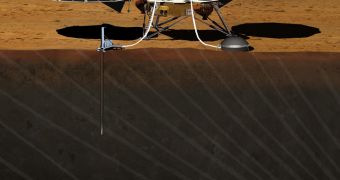Officials from the US National Aeronautics and Space Administration and the National Center of Space Studies of France (CNES) signed a new collaboration agreement yesterday, February 10. The two organizations thus agreed to work together on a Mars lander that will be launched in 2016.
The NASA-led mission is dubbed Interior Exploration Using Seismic Investigations, Geodesy, and Heat Transport (InSight) mission, and one of its main capabilities will be to drill deep underneath the Martian surface. This will enable it to collect previously inaccessible soil samples.
The agreement was signed on Monday at the Mandarin Hotel in Washington, DC, by NASA Administrator Charles Bolden and CNES president Jean-Yves Le Gall. Its terms primarily deal with cooperation between the two agencies in terms of planetary science research.
CNES is a long-term partner for NASA in exploring other planets, having participated in nearly all American missions launched over the past two decades. InSight, a mission currently scheduled to launch between March 8-27, 2016, will be no exception to this rule.
“This new agreement strengthens the partnership between NASA and CNES in planetary science research, and builds on more than 20 years of cooperation with CNES on Mars exploration,” Bolden said at the ceremony yesterday.
“The research generated by this collaborative mission will give our agencies more information about the early formation of Mars, which will help us understand more about how Earth evolved,” he added.
At this point, InSight is planned to launch aboard an Atlas V delivery system provided by the United Launch Alliance – a joint venture of the Boeing Company and Lockheed Martin. Takeoff will most likely occur from the Vandenberg Air Force Base, in California.
If all goes according to plan, InSight should land on Mars – at a yet-unknown location – by September 20, 2016. Its main instruments will be a seismometer for shock wave dissipation studies and a heat flow probe that will analyze several key physical traits of Martian soil.
CNES will be providing the Seismic Experiment for Interior Structure (SEIS) instrument, which will be used to study the meteorite impacts and tectonic activity on Mars. The dynamics of the planet's interior are a big unknown in our understanding of the Red Planet.

 14 DAY TRIAL //
14 DAY TRIAL //